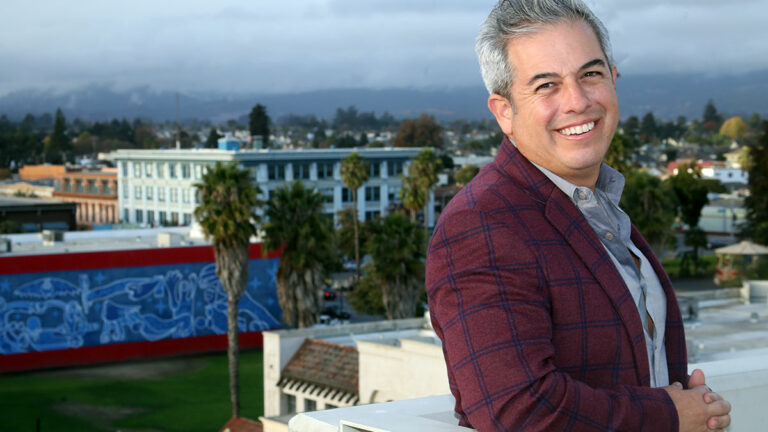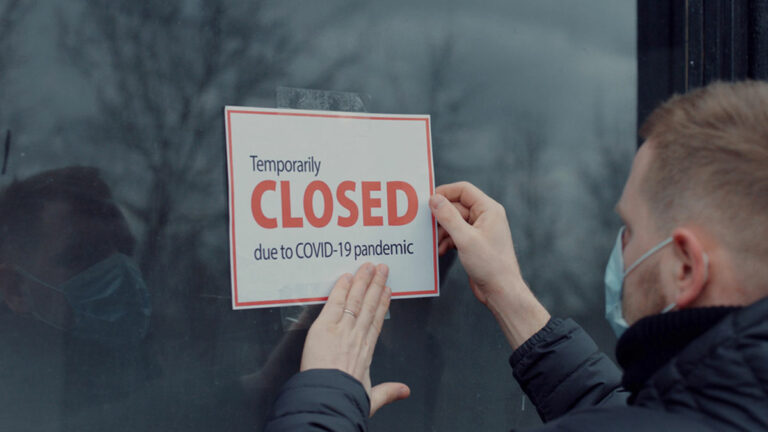In the weeks before the coronavirus began tearing through California, the city of Commerce made an expensive decision: It shut down part of its water supply.
Like nearly 150 other public water systems in California, the small city on the outskirts of Los Angeles had detected “forever chemicals” in its well water.
Used for decades to make non-stick and waterproof coatings, firefighting foams and food packaging, these industrial chemicals — per- and polyfluoroalkyl substances or PFAS — have been linked to kidney cancer and other serious health conditions.
The chemicals turned up in both of the city’s wells serving about 3,000 residents. One well already had treatment capable of reducing the chemicals, but the other did not, according to the California Water Service, which operates the wells.
The discovery forced Commerce to choose between two bad options: keep serving the contaminated water, or shut the well down and import water at more than double the cost.
Flush with funds from taxing the city’s casino and outlet mall, officials decided to err on the side of caution and shut the well down.
“We don’t take risks when it comes to drinking water,” said Gina Nila, the city’s deputy director of public works operations.
Then the pandemic struck. The casino closed for months, and the local economy took a hit. City staff were furloughed and laid off. And the tab for replacing its inexpensive underground water with costly imported water continues to climb, reaching about $460,000 in just nine months.
Now the city faces the prospect of needing to spend $1.8 million on a new treatment system, on top of its growing bill for replacement water.
“We’ll find a way to pay it,” said Commerce’s acting director of finance Josh Brooks. “It’s going to be painful.”
Rural and urban: Ubiquitous chemicals
Across California, water providers are discovering the same thing: These chemicals are everywhere. They last forever because they don’t break down. They’re dangerous. They’re expensive to get rid of. And many Californians don’t even know they’re drinking them.
California is now cracking down by implementing new thresholds for the chemicals that will force cities and utilities to shut down their wells, treat the water, or notify their customers about the contamination.
A CalMatters analysis of state data reveals that nearly 200 drinking water wells, or 15% of those tested, have exceeded the new thresholds in at least one round of testing over the past year. Although they are concentrated largely in Los Angeles, Orange and Riverside counties, contaminated wells are found statewide, in rural as well as urban areas.
At least 26 wells in hotspots, including Fresno, the East Bay and parts of Riverside and San Luis Obispo counties, contain extreme amounts of the chemicals — two to 10 times higher than the state’s recommended levels in at least one test, according to the CalMatters analysis.
“I actually think it’s scary as all get out, so we need to clean it up,” said Felicia Marcus, a visiting fellow at Stanford University’s Water in the West program and former chair of the State Water Resources Control Board. “The real question is, what is it going to take?”
Underground water is one of California’s most precious resources, providing nearly half of its drinking water, and even more in drought years. In a state where water is already scarce, the contamination of wells adds another unwelcome stressor.
The big blow to local agencies comes as the coronavirus pandemic guts cities’ budgets and their capacity to deal with yet another crisis. Groundwater is cheap, costing ratepayers much less than water imported hundreds of miles through aqueducts. Replacing the tainted water can double the cost, while removing the chemicals can cost each supplier millions of dollars in sophisticated, new treatment facilities such as reverse osmosis.
At least 146 public water systems serving nearly 16 million Californians have already detected traces of the two most pervasive chemicals — perfluorooctanoic acid (PFOA) and perfluorooctane sulfonate (PFOS) — in their well water, according to the CalMatters analysis.
The sources are ubiquitous across California: They leak into groundwater from firefighting foam used by airports and military bases, trickle off landfills and seep from industrial facilities.
“The PFAS that are in the environment today are likely to be in the environment 20 years from now or 40 years from now or 100 years from now,” said Jamie DeWitt, an associate professor of pharmacology and toxicology at East Carolina University. “And eventually you’re going to have enough in your body so that your body starts to develop diseases.”
Federal advisories for drinking water, which are not enforceable, recommend limiting PFOA and PFOS to 70 parts per trillion, combined. But California officials, concerned about the health effects, set more stringent thresholds: 10 parts per trillion for PFOA and 40 parts per trillion for PFOS.
Now, under a new state law, the water board will require providers to clean up their water or notify customers if the average concentrations exceed those thresholds, called “response levels,” over the next year.
Detecting “forever chemicals” in groundwater doesn’t necessarily mean that people are drinking high levels of them.
CalMatters’ analysis shows that some providers — including in Pico Rivera, Downey and migrant farmworker housing near Watsonville — are serving drinking water from contaminated wells that exceeded the state’s threshold in at least one test over the past year.
But 19 suppliers, including in Oroville, Atascadero, Jurupa Valley and the Santa Clarita Valley, have shut down more than 50 contaminated wells. A few, like Pleasanton, have relegated their tainted wells to emergency-use only.
And 21 suppliers, including ones in Corona, East Los Angeles, Fresno and Riverside, already have treatment systems that can filter out some of the chemicals or blend with cleaner water to dilute them. However, under the state’s new threshold, more action may now be required for some providers’ water to be clean enough to comply.
One of the hardest-hit areas is the northern half of Orange County, which gets more than 75% of its water from wells. In July, the Orange County Water District estimated that roughly 20% of 200 wells had been shut down because of the chemicals — eliminating enough water to serve hundreds of thousands of people per year. Replacing that water could add $20 a month to residents’ bills, and the costs could ultimately top $1 billion over the next 30 years, according to the district.
Finding out whether water systems are actually serving the contaminated water to people is remarkably difficult.
CalMatters contacted 67 water providers that have exceeded the new guidelines in at least one round of testing. Many repeatedly failed to respond; a few, like the cities of Lathrop and Monterey Park, refused to say whether their tainted wells were currently providing drinking water to residents.
The state water board has urged providers to notify their customers of elevated levels, but has not required it. That will change over the next year as the new law’s requirements kick in.
Californians are largely left in the dark about the safety of their drinking water: Less than 9% of roughly 14,350 public drinking water wells in the state have been tested for PFOA and PFOS. State requirements have focused on areas considered vulnerable to contamination, such as near airports and landfills.
This fall, California expanded its testing orders from roughly 600 to 900 wells, including those within a one-mile radius of previous detections. Some providers also voluntarily test their wells. (The hundreds of thousands of private wells are excluded from testing requirements.)
People can test their own water for the chemicals, but the process is costly and difficult, and only some household filters work. Residents wondering if their water supply has been tested should contact their supplier.
The low rate of testing in California means that the true extent of the contamination — and the cost of cleanup — remains unknown.
“We have an emerging problem with a lot of our water providers — contamination that is not their fault,” said Assemblymember Cristina Garcia, a Bell Gardens Democrat who wrote the law authorizing state officials to crack down on the chemicals. “So how do we fix that?”
Higher rates of serious diseases
These “forever chemicals” have been accumulating in water, soil and human bodies since the late 1940s, when 3M Co. developed a revolutionary process to make them, leading to Scotchgard and other products. Soon after, DuPont began using PFOA to make Teflon.
Prized by industry for their ability to repel water and oil, the chemicals exploded in use worldwide. After the Environmental Protection Agency learned that they were building up in people’s bodies and the environment, 3M agreed in 2000 to begin phasing out PFOS, and DuPont agreed in 2006 to phase out PFOA.
Nearly everyone in the United States carries PFOA and PFOS in their bodies — even babies, who absorb them during pregnancy and breastfeeding. In California, more than 780 people tested had an average of seven “forever chemicals” in their blood; nearly all had at least one, according to Matt Conens with the state Department of Public Health.
In 2004, the Environmental Protection Agency charged DuPont with illegally hiding evidence about the health risks of PFOA for 20 years. Then the extent of the danger to the public was revealed several years later, after residents of the Ohio Valley sued DuPont. Funded by a $70 million settlement, researchers found higher rates of diseases among people drinking water highly contaminated with PFOA from a DuPont factory in West Virginia.
The research team reported a “probable link” between PFOA and six health conditions: thyroid disease, kidney and testicular cancer, ulcerative colitis, high cholesterol and dangerously high blood pressure in pregnancy.
The chemicals also can impair the immune system, according to the National Toxicology Program. Children with high levels of PFOA and PFOS in their blood produce lower levels of antibodies after vaccination, which could reduce their ability to fight off infections.
“Now we’re discovering all these bad things, and in the meantime, the (chemicals) have multiplied and biomagnified in the environment and in human bodies,” said Philippe Grandjean, a Harvard University adjunct professor of environmental health who has studied immune effects of the chemicals.
Even as water systems struggle to clean up PFOA and PFOS, use of other substances in the massive family of perfluorinated chemicals continues. Newer chemicals were detected twice as often as the old ones at airports and landfills, according to a water board analysis.
“The train has already left the station,” Grandjean said. “And we’re just running on the platform, trying to get hold of the handle on the last car.”
‘Would they take the risk?’
Many Californians are unaware that they’re drinking traces of the chemicals.
Aracel Fernández, 51, who worked as a farm laborer until she hurt her back, has been living at the Buena Vista Migrant Center near Watsonville for the past 23 seasons. Her water tastes so unpleasant — like chlorine — that she pays $30 a month for bottled water.
But she didn’t know that the well providing her drinking water contained levels of PFOA up to 13 parts per trillion, above the state’s new recommended limit of 10 parts per trillion.
That well remains active, according to Jenny Panetta, executive director at the Housing Authority of Santa Cruz County, which operates the center and the well. “We believe the water at Buena Vista is healthy and safe, in compliance with all requirements, and we’re committed to keeping it that way,” Panetta said in an email.
Now that Fernández knows that the carcinogenic chemical is in her water, she has a question for officials who say the water is safe: Would they drink it, or let their kids and pets drink it?
“¿Se arriesgarían?” Fernández asked — “Would they take the risk?”
In Pico Rivera, a city east of Los Angeles that is 91% Latino, well water has high concentrations of PFOA. But Frances Esparza, superintendent of the El Rancho Unified School District, didn’t know about the contaminated water at her schools until she read about it in the Whittier Daily News about a year ago.
“Knowing that was in our water really concerned me,” Esparza said. “All of us are in this situation, and we’re finding out in a local newspaper? That’s not ok.”
Esparza shut down the schools’ taps and drinking fountains, purchased bottled water and spent nearly $80,000 to install filters on sinks and fountains.
Scott Bartell, a professor of public health at the University of California Irvine, also didn’t know about the contamination in his home turf of Orange County until he went looking for it. And Bartell knows these chemicals better than most: He helped investigate the health threats in the Ohio Valley and served on a World Health Organization panel reviewing the links between PFOA and cancer.
Bartell is now spearheading the California arm of a nationwide investigation into exposures to the chemicals and associated health risks, including children’s brain development.
“They build up in the body and they have the potential to be toxic,” Bartell said. And there are a lot of opportunities for people to be exposed to them. “You put all that together, and it is a concern.”
Treatment costs millions
Some water providers are trying to find millions of dollars to treat or replace their contaminated water.
In Pico Rivera, residents rely 100% on groundwater. All city-operated wells and half of the Pico Water District’s supply exceeded the state’s new recommended levels in at least one round of testing over the past year.
Some of the wells have up to twice as much PFOA as the state recommends.
“We were kind of shocked at how high they were,” said Adrian Rodriguez, water supervisor for the city of Pico Rivera.
“We didn’t cause the contamination … someone else did. We don’t know where it came from, or how it got there,” Rodriguez said. “Right now we’re barely getting a handle on it.”
Pico Rivera’s contaminated wells are still providing water. It could take at least a year and nearly $4 million to build just one treatment facility for two wells, and Pico Rivera doesn’t have the money.
“This is a big, big, big impact to our agency to be able to treat the water or install facilities in a very short time,” said Monica Heredia, director of public works.
Anaheim faces a similar plight. Its 19 wells provided about 70% of the water used by 64,000 customers. But after detecting the chemicals, the city shut down 12 of the wells, replaced them with imported water and increased residents’ rates by about $7 per month.
The Santa Clarita Valley WaterAgency, which serves more than a quarter-million people, shut down 17 of its 42 wells. Installing a new $6 million treatment facility that costs $600,000 per year to operate brought three wells serving about 5,000 households back online. But treating all of its contaminated wells will cost about $80 million upfront plus $3 million to $5 million per year, according to spokesperson Kathie Martin.
It’s the same story across the state. California Water Service has shut down PFAS-tainted wells in Chico, Marysville, Oroville and East Los Angeles, and returned a critical well to service in Visalia with a $1.6 million treatment plant.
Making matters worse, there are still thousands of other perfluorinated chemicals in use today, and treatment installed for some may not be effective for all.
Funding is scarce
Some providers pay a centralized water district to manage the groundwater — and now those agencies are putting a portion of that money toward cleanup.
“From an economic standpoint, it makes sense for us to help out our pumpers,” said Rob Beste, assistant general manager of the Water Replenishment District, which has set aside up to $34 million to help its customers pay for treatment. And with groundwater about half the cost of imported water, “it makes sense for the pumpers to treat it and still use groundwater,” he said.
But state funding to help water agencies is scarce in California. “There are many systems applying for funding, and there’s not enough money to go around,” said Daniel Newton, assistant deputy director of the state water board’s Division of Drinking Water.
To cover the costs, water providers across the state have started what legal experts suspect could become a flood of lawsuits.
The Orange County Water District has lined up seven law firms as it considers suing to recover clean-up costs projected to exceed $1 billion. Already, it has paid $1.4 million to investigate treatment techniques. The district’s legal counsel wouldn’t say which parties a lawsuit would target, but likely defendants include chemical companies.
Some water agencies already have sued 3M and DuPont, and its various spin-offs. Others are also suing the military, which has used firefighting foam containing the chemicals for decades.
“It doesn’t matter to us who pays for these as long as our customers don’t have to,” said Kathryn Horning, corporate counsel for California American Water, which is suing chemical manufacturers and the Department of Defense to help pay for a $1.3 million system to clean up a well near the former Mather Air Force Base near Sacramento.
3M spokesperson Sean Lynch said the company “acted responsibly in connection with products containing PFAS and will vigorously defend our record of environmental stewardship.” DuPont, which has undergone corporate reshuffling since making and using PFOA, would only say it was wrongly named in the suit.
Finding a way to pay for treatment will be critical, particularly as more chemicals make their way into Californians’ water.
“Certainly, in the long run, this (contamination) is going to take a lot more money,” Stanford’s Marcus said. “And a lot more thought.”
Data analysis and graphics by Youyou Zhou. Rebecca Sohn and Jackie Botts contributed to this report.
This article was supported by a grant from The Water Desk, an independent journalism initiative based at the University of Colorado Boulder’s Center for Environmental Journalism.
CalMatters is a nonprofit nonpartisan media venture explaining California policies and politics.

























